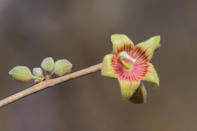
The common star-chestnut is an unusual looking tree; making it hard to miss with its fat trunk that resembles molten material both in shape and in its grey-pink colour. Although it’s not a very tall tree, the low branches make it a rather spreading specimen.
Common Star Chestnut Fruit
The ‘star-chestnut’ name is derived from the peculiar fruit which consists of three to five velvety boat-shaped carpels which are arranged in a star-like pattern. Each carpel is velvety to the touch, about 5 cm long with a prominent beak.
They are dehiscent and burst open to reveal the black seeds which are embedded in long fine hairs. The seeds are edible but one should take care not to make contact with the hairs which sting like those found on a hairy caterpillar should they touch the skin.
Common Star Chestnut Appearance
The common star-chestnut has delicate, trumpet-shaped yellow flowers decorated with red lines. These usually cover the tree before it regains the leaves that it sheds in early autumn. The fruit occurs on the tree at the same time as the flowers.
The bark is paper-like in texture and peels away to reveal a lighter red or yellowish under-colour. The under bark is very fibrous and this is harvested for use as twine for weaving fishing nets or sewing sleeping mats. The leaves of the star-chestnut are typically chestnut-shaped (3-lobed) and velvety. These are dull grey-green in colour.
Common Star Chestnut Fast Facts
Height - About 5 m
Growth form - Fat-stemmed and low-branching
Leaf type - Simple
Leaf arrangement - Alternate
Leaf margin - Entire (3-lobed)
Habitat - Low-altitude bushveld, dry and rocky areas
Deciduous or not - Deciduous
Most notable fruit/flowering season - Sept-Mar (fruits and flowers)
By Megan Emmet